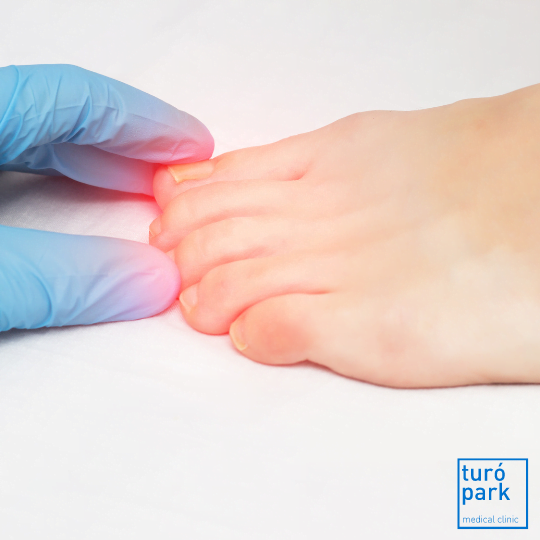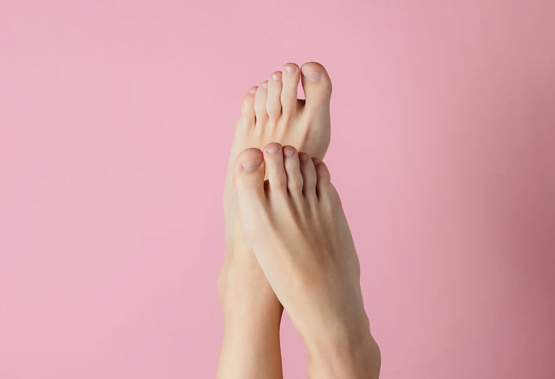Do you want to treat your ingrown toenail in Barcelona?
Caused by a bad cut of the nail and repeated traumas (too narrow shoes...), the ingrown toenail is a very common problem that needs to be treated properly to avoid complications.
If you suffer from an ingrown toenail, don't wait to make an appointment with one of our podiatrists.
What is an ingrown toenail?
Onychocryptosis, more commonly known as "ingrown toenail", refers to the embedding or penetration of a nail into the skin. Most onychocryptosis affects the big toe, but there are also cases where other toes are affected.
The condition causes pain, inflammation and redness in the surrounding tissue. In a more advanced stage, it can develop into a pyogenic infection.
Fast track your treatment
To book an appointment or speak with one of our friendly team, please get in touch using the options below.

What are the possible courses of an ingrown toenail?
There are 4 stages of onychocryptosis.
- Stage I: slight swelling and pain on pressure on the nail fold.
- Stage II: Increased pain, redness and swelling around the nail.
- Stage III: Intensification of the symptoms of the previous stage (more severe pain, almost permanent, and increased by putting on shoes). The ingrown toenail becomes infected and the pain is intense and pulsating. A purulent discharge appears in the periungual fold.
- Stage IV: If the ingrown toenail is left untreated, the periungual ridge becomes hypertrophic. A granulation tissue in the form of a large red raspberry-shaped bud, called botryomycoma, appears. Walking becomes very painful and the risk of falling increases.
Ingrown toenail: what causes it?
Certain factors favour the appearance of an ingrown toenail:
- Wearing narrow or pointed shoes
- Certain foot shapes such as the Greek or Egyptian foot
- Hyperextension of the big toe
- Certain abnormalities in the shape or thickness of the nail
- Pronation (lowering of the arch) of the foot
- Hyperhidrosis (excessive sweating)
- Trauma or improper cutting of the nail.
All of these factors can also combine to cause the nail to penetrate the soft tissue, resulting in an initial mild pain that becomes more intense over time.
How do you treat an ingrown toenail?
Immediate treatment of an ingrown toenail will aim to reduce the pain, inflammation and infection, if any.
The podiatrists at Turo Park Clinics will then offer two types of treatment depending on the course of the condition and the factors that caused the ingrown toenail.
During the consultation, a preliminary assessment is carried out in order to choose the best treatment for each patient.
This is mainly a minor correction of the nail without surgery. This type of treatment is indicated for stages I and II.
The podiatrist first removes the part of the nail that is causing the onychocryptosis, either with straight scissors or with a scalpel. Once the edge of the nail has been removed, he applies an antibiotic and/or anti-inflammatory ointment depending on the condition of the affected toe.
Afterwards, he takes the time to educate the patient in order to modify or eliminate the factors that caused the ingrown toenail to appear.
Other treatments include the use of corrective orthotics and digital discharge or nail correctors.
How can I avoid an ingrown toenail?
To avoid ingrown toenails, it is essential to learn how to take care of your nails:
- Cut your nails after a bath or shower, when they are soft
- Cut the nails straight and not in a semicircle, leaving the nail extending two to three millimetres beyond the free edge of the toe
- Use nail scissors and cuticle clippers, cleaned with alcohol
- Do not pick at the cuticles
- Do not use sharp instruments to clean under the nail.
In addition to nail hygiene, it is also recommended to wear comfortable shoes and to use cotton wool socks.
Healthy feet, the basis for a healthy body.
Our podiatrists are available to diagnose and treat all your posture and foot problems.

Our multilingual podiatrists
